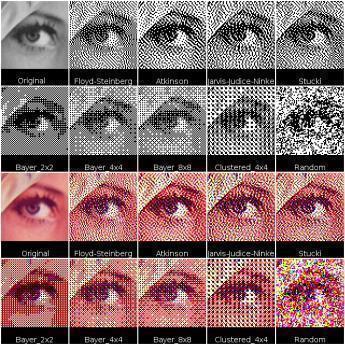Related Topics
Academia (2)
continued.
Computers, Digital Cameras, and Cellphones
Much of the early development of the electronic computer took place in Philadelphia. We lost the lead, but it might return.
Favorites - II
More favorites. Under construction.
On Writing History
History doesn't write itself.
Dithering History

Dithering is originally a photographic term, referring to the process of smoothing out rough parts of an excessively enlarged photo. Carried over to the profession of writing history, the term alludes to smoothing over the rough parts of a narrative with a little unacknowledged conjecturing.
In photography, when a picture is enlarged too far, it breaks apart into bits and pieces. Dithering fills in the blank gaps between "pixels" actually recorded by the camera. It amounts to guessing what a blank space should look like, based on what surrounds its edges. In the popular comic strip, Blondie's husband Dagwood works for an explosive boss called Mr. Dithers, who "dithers" between outbursts, when he vents his frustration. But that's to dither in the Fifteenth-century non-technical sense, meaning to hesitate in an aimless trembling way. If the cartoonist who draws Blondie will forgive me, I have just dithered in the sense I am discussing in history. I haven't the faintest idea what the cartoonist intended by giving his character the name of Mr. Dithers, so I invented a plausible theory out of what I do know. That's what I mean by a third new meaning for either, in the sense of "plausible but wholly invented". It's fairly common practice, and it is one of the things which Leopold von Ranke's insistence on historical documentation has greatly reduced.
To digress briefly about photographic dithering, the undithered product is of degraded quality, to begin with. Dithering systematically removes the jagged digital edge, and restores the original analog signal. In that case, dithering the result brings it back toward the original picture. That's not cheating, it's the removal of a flaw.
Dithering of history comes closer to resembling a different photographic process, which samples the good neighboring pixels on all sides of a hole and synthesizes an average of them to cover the hole. It works best with four-color graphics, converting them to 256-color approximations. But the key to all photographic approaches is to apply the same formula to all pixel holes. That's something a computer can do but a historian can't, and historical touch-ups seem less legitimate because the reader can't recognize when it has happened, can't reverse it by adding or removing a filter. Dithering may somewhat improve the readability of the history product occasionally, usually at the expense of inaccuracy, sometimes large inaccuracy. It's conventional among more conscientious writers to signal what has happened by signaling, "As we can readily imagine Aaron Burr saying to Alexander Hamilton just before he shot him." That's less misleading than just saying "Burr shouted at Hamilton, just before he blew his brains out." The latter sends no signal or footnote to the reader, except perhaps to one who knows that Hamilton was shot in the pelvis, not the head. In small doses, dithering may harmlessly smooth out a narrative. But there's a better approach, to write history in short blogs of what is provable, later assembling the blogs like beads in a necklace. Bridges may well need to be added to smooth out the lumps, but that becomes a late editorial step, consciously applied with care. And consequently, author commentary is more likely to recognized as commentary, rather than rejected as fiction.
Dithering the holes is often just padding. It would be better to spend the time doing more research.
Originally published: Tuesday, January 22, 2013; most-recently modified: Thursday, May 16, 2019